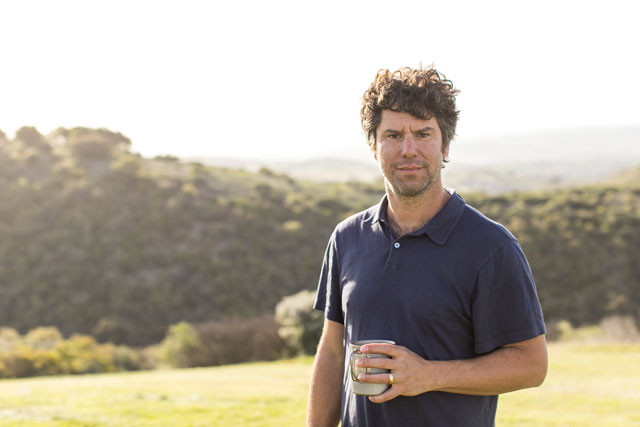
Winemaker Jason Joyce of Calcareous.
If you’ve never visited Calcareous, you are missing out on two things, beautiful wines and amazing property with stunning views. If you have been to their tasting room you probably haven’t been just once. Before you plan your trip to their tasting room, let’s learn a bit more about them through the Q&A below with winemaker, Jason Joyce. Thank you to Jason for taking the time out to do this during harvest, which can be a demanding time of year. – Matt Browne
What did you do prior to getting into the wine industry?
Before winemaking I was an organic chemist synthesizing novel trial pharmaceuticals.
What was your first job in the industry?
My first time working in wine was being a cellar intern for the 2007 harvest here at Calcareous. I had friends from my time at Cal Poly who were working in Paso wine, and when I wanted a short break from living in San Francisco and working in a chem lab, they found me a seasonal cellar job. It was not a long-term plan, was supposed to be just a fun hiatus.
How many cases of wine are made at Calcareous?
We will produce around 9,000 cases at Calcareous this vintage.
What varieties are you focused on at Calcareous?
Our production is wide-ranging but emphasizes Rhone and Bordeaux-style reds with a good amount of zinfandel and even pinot noir thrown in. We also produce chardonnay, Rhone-style whites and a different rose each vintage.
Where are you from originally?
I am originally from the great American viticulturist breeding ground of Detroit Michigan. I discovered the Central Coast of California as a chemistry student at Cal Poly.
What is your favorite food and wine pairing?
My favorite food and wine pairing would be grenache blanc with chips and guacamole. This changes all the time, but this past summer that has been a constant and fantastic staple.
What is your favorite thing about the wine industry?
The best thing about the wine industry is that it requires the use of all your senses, touch, taste, smell. In such a visually dominated world, it is a rare gift to have a job that requires so much of you and is also aligned with the seasons and paying attention to the environment around you. It is a deeply human profession.
What is your philosophy on wine and winemaking?
My overriding winemaking philosophy is don’t mess it up. The best a wine will ever taste is the moment you pick it, and everything you do in the cellar can only make it worse, not better. The goal is always to capture that fruit as purely as you can in the finished wine.
Are all of Calcareous wines from estate-grown grapes?
We currently grow around 60 acres of vines which compromises about 80% of the wine we produce. We purchase grapes from just a couple of neighboring vineyards that work well with our estate fruit.
Many people talk about having that ‘Aha’ moment that gets them into wine, did you have that and if so, what was it?
The closest thing I had to an ‘Aha’ moment with wine making is that it came rather naturally. My way of thinking and planning matches rather well to the job, and once I learned how to get any ego out of the way and just trust the vineyards and fruit, it became and very organic process.
Do you see any interesting new trends for the Paso Robles wine country?
The trend I hope to see get more traction in winemaking is allowing a bit of control loss. So much of the way winemaking is taught and implemented is to narrow things down. Single varietal, single clone, one level of ripeness, single yeast… it goes on and on as ways to attempt full control of the process. But if you take the chance to let things happen, (and not talking about “natural wine” which is a marketing term for not wanting to have to work hard), the winemaking environment will produce things you never intended that will be of greater interest then whatever “plan” it was you had going into making the wine.
What’s your favorite current wine variety to consume?
My favorite thing to drink right now is well-crafted old-world wines. That is what inspires me, making wines from vineyards that are not homogeneous in any way produces these wide-ranging flavors and textures that are just fascinating. As long as it is well done because you can have all the great interesting fruit in the world, but if you don’t craft it and stay vigilant, all you taste is weird wild yeast flavors and vinegar that overpower what gifts you were given by the fruit.











